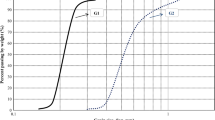Abstract
Engineering activities can lead to serious soil erosion problems in red bed areas. To overcome their loose structure, low strength and poor water retention, the red bed weathered soil needs to be modified with adhesives and water-retaining agents. At present, on the premise of applying adhesive, there are few studies on the mechanism of water retention agent to improve soil, and the amount of water retention agent in practical engineering is mainly determined by experience, lacking reliable quantitative basis. Herein, the effects of water-retaining agents on soil quality were quantitatively studied in red bed weathered soil modified by a fixed amount of adhesive. By using shear, permeability, porosity and plant growth tests, we show that the shear strength of the modified soils decreased slightly with increasing resin content, while permeability, porosity and water retention increased, and the growth of plant roots was promoted. Additionally, the processes by which these soil agents improve water retention were investigated, and the control mechanism of the optimum addition amount of water-retaining agent based on the soil water storage and aggregate size was revealed by scanning electron microscopy (SEM) and nuclear magnetic resonance (NMR) images, and the optimal water-retaining resin dosage for red bed weathered soil modification is proposed. This study provides a quantitative basis for determining water-retaining agent dosage in the red bed areas of South China and similar areas.










Similar content being viewed by others
References
Abrol V, Shainberg I, Lado M, Ben-Hur M (2013) Efficacy of dry granular anionic polyacrylamide (PAM) on infiltration, runoff and erosion. Eur J Soil Sci. https://doi.org/10.1111/ejss.12076
Ajalloeian R, Matinmanesh H, Abtahi SM, Rowshanzamir M (2013) Effect of polyvinyl acetate grout injection on geotechnical properties of fine sand. Geomech Geoengin. https://doi.org/10.1080/17486025.2012.705897
Arbona V, Iglesias DJ, Jacas J et al (2005) Hydrogel substrate amendment alleviates drought effects on young citrus plants. Plant Soil. https://doi.org/10.1007/s11104-004-1160-0
Asavadorndeja P, Glawe U (2005) Electrokinetic strengthening of soft clay using the anode depolarization method. Bull Eng Geol Environ. https://doi.org/10.1007/s10064-005-0276-7
Bai W, Zhang H, Liu B et al (2010) Effects of super-absorbent polymers on the physical and chemical properties of soil following different wetting and drying cycles. Soil Use Manag. https://doi.org/10.1111/j.1475-2743.2010.00271.x
Berendse F, van Ruijven J, Jongejans E, Keesstra S (2015) Loss of plant species diversity reduces soil erosion resistance. Ecosystems. https://doi.org/10.1007/s10021-015-9869-6
Buchmann C, Schaumann GE (2018) The contribution of various organic matter fractions to soil–water interactions and structural stability of an agriculturally cultivated soil. J Plant Nutr Soil Sci. https://doi.org/10.1002/jpln.201700437
El-Saied H, Waley AI, Basta AH, El-Hadi O (2004) High-water absorbents from lignocelluloses. II. Novel soil conditioners for sandy soil from lignocellulosic wastes. Polym - Plast Technol Eng. https://doi.org/10.1081/PPT-120038064
Hengsdijk H, Meijerink GW, Mosugu ME (2005) Modeling the effect of three soil and water conservation practices in Tigray, Ethiopia. Agric Ecosyst Environ. https://doi.org/10.1016/j.agee.2004.06.002
Kalkan E (2012) Effects of waste material-lime additive mixtures on mechanical properties of granular soils. Bull Eng Geol Environ. https://doi.org/10.1007/s10064-011-0409-0
Kochetkova RG (2012) Influence of modern stabilizers on improved properties of clayey soils. Soil Mech Found Eng. https://doi.org/10.1007/s11204-012-9160-1
Latifi N, Horpibulsuk S, Meehan CL et al (2017) Improvement of problematic soils with biopolymer-an environmentally friendly soil stabilizer. J Mater Civ Eng. https://doi.org/10.1061/(ASCE)MT.1943-5533.0001706
Lentz RD, Shainberg I, Sojka RE, Carter DL (1992) Preventing irrigation furrow erosion with small applications of polymers. Soil Sci Soc Am J. https://doi.org/10.2136/sssaj1992.03615995005600060046x
Li SC, Sun HL, Yang ZR, et al (2006) Effect of straw fiber, polyacrylamide and super absorbent polymer ecological engineering on rock slope protection. Yanshilixue Yu Gongcheng Xuebao/Chinese J Rock Mech Eng
Liu J, Shi B, Jiang H et al (2009) Improvement of water-stability of clay aggregates admixed with aqueous polymer soil stabilizers. Catena. https://doi.org/10.1016/j.catena.2008.12.016
Metzger JO, Hüttermann A (2009) Sustainable global energy supply based on lignocellulosic biomass from afforestation of degraded areas. Naturwissenschaften. https://doi.org/10.1007/s00114-008-0479-4
Miller GA, Zaman M (2000) Field and laboratory evaluation of cement kiln dust as a soil stabilizer. Transp Res Rec. https://doi.org/10.3141/1714-04
Onyejekwe S, Ghataora GS (2015) Soil stabilization using proprietary liquid chemical stabilizers: sulphonated oil and a polymer. Bull Eng Geol Environ. https://doi.org/10.1007/s10064-014-0667-8
Shahnavaz M, Nourzadeh Haddad M, Gholami A, Panahpour E (2019) Investigation the efficiency of soil stabilizers against soil loss and their effects on chemical properties of soil. Arid L Res Manag. https://doi.org/10.1080/15324982.2018.1531324
Tavakoli E, He S, Yu X, Hoyos LR (2018) Laboratory evaluation of a liquid ionic stabilizer for an expansive soil in North Texas. In: Geotechnical Special Publication
Verma AK, Sindhu SS, Singh A et al (2019) Conditioning effects of biodegradable superabsorbent polymer and vermi-products on media properties and growth of gerbera. Ecol Eng. https://doi.org/10.1016/j.ecoleng.2019.03.012
Wu TH, Watson A (1998) In situ shear tests of soil blocks with roots. Can Geotech J. https://doi.org/10.1139/t98-027
Zhao Y, Zhuang J, Wang Y et al (2020) Improvement of loess characteristics using sodium alginate. Bull Eng Geol Environ. https://doi.org/10.1007/s10064-019-01675-z
Zhou C, Zhao S, Huang W et al (2019) Study on the stabilization mechanisms of clayey slope surfaces treated by spraying with a new soil additive. Appl Sci. https://doi.org/10.3390/app9061245
Zong Q, Feng B, Cai H et al (2018) Mechanism of riverbank protection by desert riparian vegetation roots in Tarim River basin. Yanshilixue Yu Gongcheng Xuebao/Chinese J Rock Mech Eng. https://doi.org/10.13722/j.cnki.jrme.2017.1371
Funding
This research is financially supported by Major Programs Special Funds of Applied Science and Technology Research and Development of Guangdong Province (No.2015B090925016), The National Key Research and Development Project of China (No.2017YFC1501201), and The National Key Research and Development Project of China (No.2017YFC0804605).
Author information
Authors and Affiliations
Corresponding author
Ethics declarations
Conflict of interest
The authors declare no conflict of interest.
Rights and permissions
About this article
Cite this article
Zhou, C., Huang, W., Qiu, S. et al. A quantitative study on the amount of water-retaining agent based on adhesive-modified red bed weathered soil. Bull Eng Geol Environ 80, 3139–3150 (2021). https://doi.org/10.1007/s10064-021-02113-9
Received:
Accepted:
Published:
Issue Date:
DOI: https://doi.org/10.1007/s10064-021-02113-9




